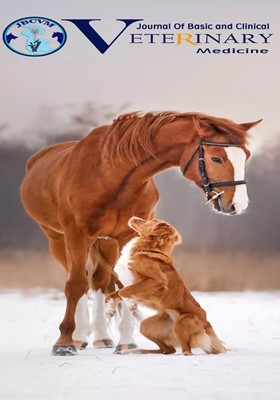Intra-abdominal Necrotic Lipoma in a Terrier dog
Subject Areas : Pathology
Farshad Baghban
1
![]() ,
Maziar Manshaei
2
,
Mohammad Hossein Saljooghian
3
,
Mohammad Sadegh Ashtari
4
,
Maziar Manshaei
2
,
Mohammad Hossein Saljooghian
3
,
Mohammad Sadegh Ashtari
4
1 - Department of Veterinary Medicine, Yasooj Branch, Islamic Azad University, Yasooj, Iran
2 - Department of Clinical Sciences, Faculty of Veterinary Medicine, Sharekord Branch, Islamic Azad University, Sharekord, Iran
3 - Department of Clinical Sciences, Faculty of Veterinary Medicine, Sharekord Branch, Islamic Azad University, Shahrekord, Iran
4 - Veterinary Radiologist, Apadana Veterinary Clinic, Isfahan, Iran
Keywords: Histopathology, Dog, terrier, Intra-abdominal Lipoma, Fat Necrosis,
Abstract :
A ten-year-old female unspayed terrier, weighing 13 kg, presented for chronic abdominal distention, urinary incontinence, and pollakiuria suspected of urinary bladder infection. Physical examination revealed abdominal pressure with pain in palpation. Other clinical signs of the vital organs were in the normal range. Hematology and biochemistry and urinalysis were done. Hematological examination, due to neutrophilia, showed increased white blood cell count (27.6 X 109/L). Other hematological parameters were in the normal range. Biochemical parameters including, albumin, total protein, creatinine, globulin, alanine transaminase (ALT) and aspartate aminotransferase (AST), and uric acid were in normal range except alkaline phosphatase (ALP) (160 IU/L) was higher than the normal range. Radiography and ultrasonography revealed an abdominal mass, measuring (100mm X 74mm X 56mm) near the descending colon. Ventrodorsally (VD) abdominal radiography demonstrated an oval soft tissue mass with areas of mineralization, caudal of the abdomen which displaced descending colon left laterally and was adjacent to the left kidney. Exploratory laparotomy was performed to remove the fatty mass. Histopathological examination revealed a necrotic and moderately calcified cystic lipoma.
[1] Lynch S, Halfacree Z, Desmas I, Cahalan SD, Keenihan EK, Lamb CR. Pulmonary lipoma in a dog. Journal of Small Animal Practice. 2013; 54(10): 555-58. doi:10.1111/jsap.12096
[2] Strafuss AC, Smith J E, Kennedy G A, Dennis S M. Lipomas in dogs. Journal of American Animal Hospital Association.1973; 9: 555-61.
[3] Mayhew PD, Brockman DJ. Body cavity lipomas in six dogs. Journal of Small Animal Practice. 2002; 43 (4): 177-81. doi:10.1111/j.1748-5827.2002.tb00053
[4] Huppes RR, Dal Pietro N, Wittmaack MC, Sembenelli G, Marchiore Bueno C, Morais Pazzini J and et al. Intermuscular Lipoma in Dogs. Acta Scientiae Veterinariae. 2016; 44(Suppl 1): 1-7.
[5] Kim HJ, Kim SY, Kim SS, Yun SK, Lee JS Hong SK, Kim WH, Kim YB, Yoon J, Choi M. Intra-abdominal necrotic lipoma diagnosed by computed tomography as a paraprostatic cyst. Journal of Veterinary Science. 2017; 18(4): 559-61. doi:10.4142/jvs.2017.18.4.559
[6] O’Neill DG, Corah CH, Church DB, Brodbelt DC, Rutherford L. Lipoma in dogs under primary veterinary care in the UK: prevalence and breed associations. Canine Genetics and Epidemiology. 2018; 5(9): 1-13.
doi:10.1186/s40575-018-0065-9
[7] Beck A, Stejskal M, Butković V, Šoštarić-Zuckermann IC, Kurilj AG, Grabarević Ž. Necrotic omental lipoma in a dog as an unusual cause of sclerosing encapsulating peritonitis - a case report. Veterinary Archives. 2012; 82(4): 391-99.
[8] Clapp K, Rademacher N, Gaschen L. Imaging diagnosis-intra-abdominal lipoma. Veterinary Radiology & Ultrasound. 2009; 50(6): 644-45.
doi:10.1111/j.1740-8261.2009.01597
[9] Hammond TN, Regan J. (2008) Imaging diagnosis--intra-abdominal necrotic lipoma. Veterinary Radiology & Ultrasound. 2007; 49 (4):365-367.
doi:10.1111/j.1740-8261.2008.00382
[10] Meuten, D. J. ed. Tumors in Domestic Animals. 4th ed. Iowa State Press, Ames, IA, USA. 2017; pp: 595-96.
[11] Bacon N. Adipose tumours. In: Dobson JM, Lascelles BDX (eds.). BSAVA Manual of Canine and Feline Oncology. 3rd ed. Wiley, Gloucester, 2011. pp:178-90.
[12] Valenti p, Pellegrino V, Muscatello LV, Brunetti B, Zambon E, Gerboni GM, et al. The Site of Origin of Canine Abdominal Masses Correlates with the Risk of Malignancy: Retrospective Study of 123 Cases. Animals. 2021; 11(4): 962. doi:10.3390 /ani11040962
[13] Dobson JM. Breed-predispositions to cancer in pedigree dogs. ISRN Veterinary Science. 2013; 1-23. doi:10.1155/2013/941275
[14] Bird JE, Morse LJ, Feng L, Wang W-L, Lin PP, Moon BS, et al. Non-radiographic risk factors differentiating atypical Lipomatous tumors from lipomas. Frontiers in Oncology. 2016; 6: 197. doi:10.3389/fonc.2016.00197
[15] Kolb L, Barazi H, Rosario-Collazo JA. Lipoma. [Updated 2019 Jun 3]. In: StatPearls. Treasure Island (FL): StatPearls Publishing; 2019. Available from: https://www.ncbi.nlm.nih.gov/books/NBK507906/.
[16] The Kennel Club: Breed Standards Information: Dog Breeds & Groups. 2018. https://www.thekennelclub.org.uk/activities/dog-showing/breed-standards/.
[17] Grüntzig K, Graf R, Boo G, Guscetti F, Hässig M, Axhausen KW, et al. Swiss canine Cancer registry 1955-2008: occurrence of the most common tumour diagnoses and influence of age, breed, body size, sex and neutering status on tumour development. Journal of Comparative Pathology. 2016; 155 (2-3): 156-70.
doi:10.1016/j.jcpa.2016.05.011
[18] Creevy KE, Austad SN, Hoffman JM, O'Neill DG, Promislow DEL. The Companion Dog as a Model for the Longevity Dividend. In: Olshansky SJ,
Kirkland JL, Martin GM, editors. Aging: The Longevity Dividend. 6. Cold
Spring Harbor: Cold Spring Harbor Laboratory Press; 2016; pp: 107-20.
doi:10.1101/cshperspect.a026633
[19] Smith AN. The role of neutering in Cancer development. Veterinary Clinics: Small Animal Practice. 2014; 44(5): 965-75. doi:10.1016/j.cvsm.2014.06.003
[20] Jeusette I, Detilleux J, Cuvelier C, Istasse L, Diez M. Ad libitum feeding following ovariectomy in female beagle dogs: effect on maintenance energy requirement and on blood metabolites. Journal of Animal Physiology and Animal Nutrition (Berl). 2004; 88(3–4): 117-21. doi:10.1111/j.1439-0396.2003.00467


